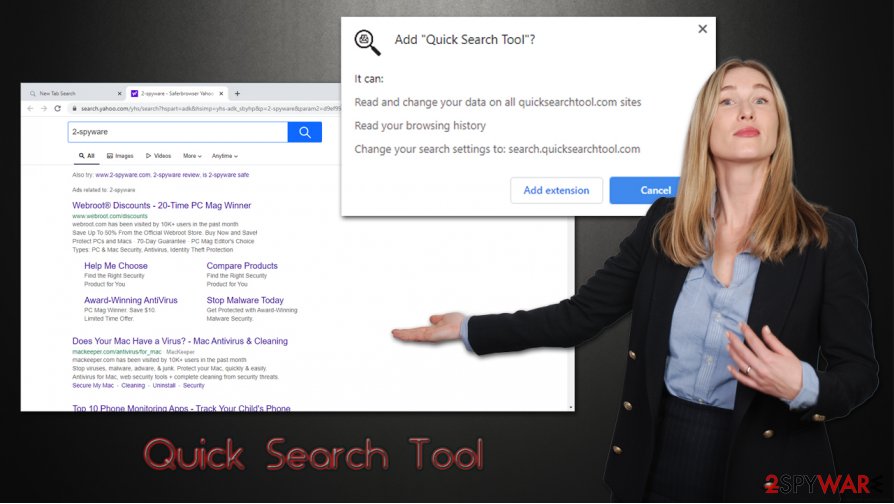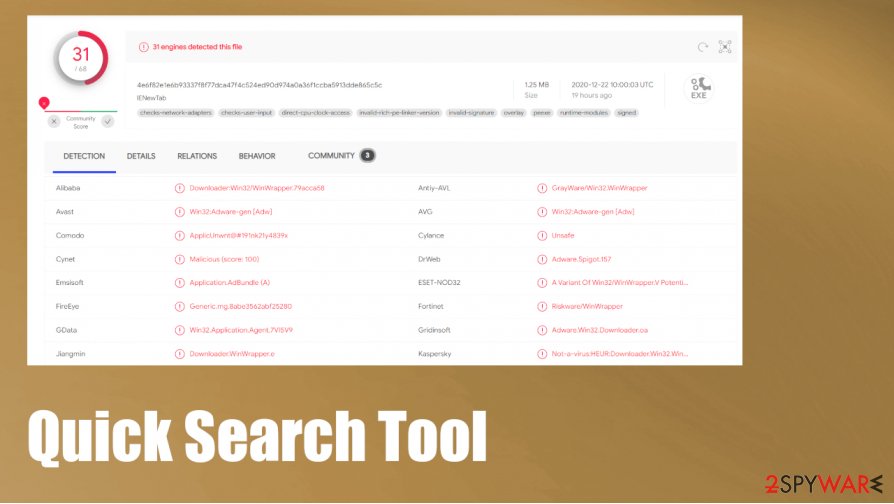Quick Search Tool (Easy Removal Guide) - Free Instructions
Quick Search Tool Removal Guide
What is Quick Search Tool?
Quick Search Tool is a browser hijacker that seeks to profit from intrusive advertisements

Quick Search Tool is a browser extension that users might download from Google Web store or other reputable sources, although it is most commonly installed along other software downloaded from third-party websites. Since the app is distributed via software bundles (which usually results in unintentional installation), it is categorized as a potentially unwanted program.[1]
It uses typical techniques to change Google Chrome, Mozilla Firefox, MS Edge, Safari, or another web browser settings:
- Changes homepage/new tab URL to search.quicksearchtool.com
- Redirects all searches to search.yahoo.com
- Fills search results with sponsored links and ads.
Besides, the Quick Search Tool virus is also designed to track users' web browsing activities in the background and use these details to deliver targeted advertisements, monetizing ad clicks, or software installs in the process.
| Name | Quick Search Tool |
| Type | Browser hijacker, potentially unwanted program |
| Distribution | Official sources such as Google Web Store, software bundle packages, deceptive advertisements, fake update prompts |
| Symptoms | The browser extension installed on the web browser; homepage and the new tab URL is set to search.quicksearchtool.com; all searches are redirected to Yahoo; search results are littered with sponsored links and other advertisements |
| Dangers | Other potentially unwanted app installation, personal information disclosure to unknown parties, financial losses |
| Removal | You can uninstall most of the potentially unwanted applications with the help of powerful anti-malware software or by following our elimination guide below |
| System fix | In case an anti-malware scan found viruses on your machine, your machine might no longer operate as it did previously. FortectIntego can detect corrupted or deleted system files and restore them for the best computer performance after a malware infection |
This browser hijacker might be often referred to as the virus due to its deceptive infiltration techniques. As noted, PUPs often use software bundles for distribution purposes – these often result in an unintentional installation by the user. As a result, users simply find the add-on or a program installed on their machine, even though they believe that they never gave permission for the software to be installed in the first place.
However, it is not entirely true, as browser hijackers such as Quick Search Tool are installed by users themselves, regardless if it was done without asking them for direct permission. Thus, authors of such apps can point at Terms and Conditions that were accepted during the installation procedure.
Once inside a computer, Quick Search Tool browser hijacker quickly changes the settings of the browser it was installed on. Therefore, one of the first symptoms of infections is the homepage and the new tab URL changes that are usually spotted by users. Nonetheless, we noticed that the app tries to imitate Google's search engine but removes the search bar, making users search the web via its domain.
The next change that users might notice is that the search results are redirected to Yahoo – a legitimate IT company that has been around for years. At the top of the results, several sponsored links, marked as ads, are located, although they are presented in a manner that would make users believe that they are genuine.
The redirect feature that shows users these sponsored links and ads, as Yahoo itself has nothing to do with these. Then again, if the search engine of this reputable company is used, then why not avoid advertisements, as well as potentially dangerous sites and remove Quick Search Tool altogether? You can do that with SpyHunter 5Combo Cleaner or Malwarebytes tools.

Another reason for Quick Search Tool removal is its data gathering and sharing practices. All the users who have this browser extension installed on their systems are being tracked – this information (IP address, device information, browser settings, language preferences, system activity, installed extensions, etc.)[2] is even provided once the app is inserted into the browser:
Add “Quick Search Tool”?
It canL
Read and change your data on all quicksearchtool.com sites
Read your browsing history
Change search settings to: search.quicksearchtool.com
Thus, we recommend you uninstall Quick Search Tool virus immediately, as it does not provide any value, but rather tracks you in order to deliver ads during your web browsing sessions. You can eliminate the extension by accessing your web browser settings.
If the elimination process is not successful or ads and other suspicious activity does not stop, we suggest you scan your machine with anti-malware software, reset the web browser as explained below, and then attempt to repair your system with FortectIntego if such need arises.
Stay away from shady ads to avoid potentially unwanted programs
Potentially unwanted programs such as browser hijackers are not considered to be major security threats as ransomware, Trojans, or other malicious programs are. However, security researchers[3] always advise keeping the machine clutter-free, as PUPs can serve as one of the reasons why malware gains access to the computer in the first place. Redirects, deceptive ads, and online scam sites can be encountered at any time, and less experienced users might be tricked into installing malware on their systems.
Besides, browser hijackers are also often used as major information-gathering tools – this data is later shared with affiliates and other parties for marketing purposes. The main goal of PUPs is to deliver minimal functionality for maximum user exposure to advertisements.
To avoid potentially unwanted applications, you should first ensure that you proceed with freeware installations carefully, as software bundling is often used. Thus, never rush the installation process, watch out for pre-ticked boxes, decline all the offers, and always choose Advanced settings instead of the Recommended ones when prompted.
Finally, a comprehensive security program can also warn you about incoming threats, as long as it includes a PUP detection feature.

Eliminate Quick Search Tool virus from your browser immediately
There are several reasons why you should remove Quick Search Tool, although the main concern should be security and privacy. It is not uncommon for browser hijackers and other potentially unwanted programs to travel together, so there is a possibility that other PUPs or malware are present on your machine.
Thus, you should first eliminate the hijacker that you know is attached to your web browser. In most cases, all the installed extensions should be visible right away, although some apps might deliberately hide their presence. In such a case, accessing the “Extensions” section of your web browser should suffice to perform a full Quick Search Tool removal.
If the browser changes remain, you should reset Google Chrome, Mozilla Firefox, or another web browser the extension is attached to. If that does not help and you still see ads and redirects, you should perform a full system scan with anti-malware software.
You may remove virus damage with a help of FortectIntego. SpyHunter 5Combo Cleaner and Malwarebytes are recommended to detect potentially unwanted programs and viruses with all their files and registry entries that are related to them.
Getting rid of Quick Search Tool. Follow these steps
Uninstall from Windows
To get rid of potentially unwanted programs on Windows operating systems, follow these steps:
Instructions for Windows 10/8 machines:
- Enter Control Panel into Windows search box and hit Enter or click on the search result.
- Under Programs, select Uninstall a program.

- From the list, find the entry of the suspicious program.
- Right-click on the application and select Uninstall.
- If User Account Control shows up, click Yes.
- Wait till uninstallation process is complete and click OK.

If you are Windows 7/XP user, proceed with the following instructions:
- Click on Windows Start > Control Panel located on the right pane (if you are Windows XP user, click on Add/Remove Programs).
- In Control Panel, select Programs > Uninstall a program.

- Pick the unwanted application by clicking on it once.
- At the top, click Uninstall/Change.
- In the confirmation prompt, pick Yes.
- Click OK once the removal process is finished.
Delete from macOS
In case you found that your Mac is suffering from redirects and other issues, perform these steps:
Remove items from Applications folder:
- From the menu bar, select Go > Applications.
- In the Applications folder, look for all related entries.
- Click on the app and drag it to Trash (or right-click and pick Move to Trash)

To fully remove an unwanted app, you need to access Application Support, LaunchAgents, and LaunchDaemons folders and delete relevant files:
- Select Go > Go to Folder.
- Enter /Library/Application Support and click Go or press Enter.
- In the Application Support folder, look for any dubious entries and then delete them.
- Now enter /Library/LaunchAgents and /Library/LaunchDaemons folders the same way and terminate all the related .plist files.

Remove from Microsoft Edge
Delete unwanted extensions from MS Edge:
- Select Menu (three horizontal dots at the top-right of the browser window) and pick Extensions.
- From the list, pick the extension and click on the Gear icon.
- Click on Uninstall at the bottom.

Clear cookies and other browser data:
- Click on the Menu (three horizontal dots at the top-right of the browser window) and select Privacy & security.
- Under Clear browsing data, pick Choose what to clear.
- Select everything (apart from passwords, although you might want to include Media licenses as well, if applicable) and click on Clear.

Restore new tab and homepage settings:
- Click the menu icon and choose Settings.
- Then find On startup section.
- Click Disable if you found any suspicious domain.
Reset MS Edge if the above steps did not work:
- Press on Ctrl + Shift + Esc to open Task Manager.
- Click on More details arrow at the bottom of the window.
- Select Details tab.
- Now scroll down and locate every entry with Microsoft Edge name in it. Right-click on each of them and select End Task to stop MS Edge from running.

If this solution failed to help you, you need to use an advanced Edge reset method. Note that you need to backup your data before proceeding.
- Find the following folder on your computer: C:\\Users\\%username%\\AppData\\Local\\Packages\\Microsoft.MicrosoftEdge_8wekyb3d8bbwe.
- Press Ctrl + A on your keyboard to select all folders.
- Right-click on them and pick Delete

- Now right-click on the Start button and pick Windows PowerShell (Admin).
- When the new window opens, copy and paste the following command, and then press Enter:
Get-AppXPackage -AllUsers -Name Microsoft.MicrosoftEdge | Foreach {Add-AppxPackage -DisableDevelopmentMode -Register “$($_.InstallLocation)\\AppXManifest.xml” -Verbose

Instructions for Chromium-based Edge
Delete extensions from MS Edge (Chromium):
- Open Edge and click select Settings > Extensions.
- Delete unwanted extensions by clicking Remove.

Clear cache and site data:
- Click on Menu and go to Settings.
- Select Privacy, search and services.
- Under Clear browsing data, pick Choose what to clear.
- Under Time range, pick All time.
- Select Clear now.

Reset Chromium-based MS Edge:
- Click on Menu and select Settings.
- On the left side, pick Reset settings.
- Select Restore settings to their default values.
- Confirm with Reset.

Remove from Mozilla Firefox (FF)
Remove dangerous extensions:
- Open Mozilla Firefox browser and click on the Menu (three horizontal lines at the top-right of the window).
- Select Add-ons.
- In here, select unwanted plugin and click Remove.

Reset the homepage:
- Click three horizontal lines at the top right corner to open the menu.
- Choose Options.
- Under Home options, enter your preferred site that will open every time you newly open the Mozilla Firefox.
Clear cookies and site data:
- Click Menu and pick Settings.
- Go to Privacy & Security section.
- Scroll down to locate Cookies and Site Data.
- Click on Clear Data…
- Select Cookies and Site Data, as well as Cached Web Content and press Clear.

Reset Mozilla Firefox
If clearing the browser as explained above did not help, reset Mozilla Firefox:
- Open Mozilla Firefox browser and click the Menu.
- Go to Help and then choose Troubleshooting Information.

- Under Give Firefox a tune up section, click on Refresh Firefox…
- Once the pop-up shows up, confirm the action by pressing on Refresh Firefox.

Remove from Google Chrome
In some cases, browser extensions set up certain rules within the infected system that prevent their elimination. To bypass this, reset Google Chrome and get rid of the unwanted settings:
Delete malicious extensions from Google Chrome:
- Open Google Chrome, click on the Menu (three vertical dots at the top-right corner) and select More tools > Extensions.
- In the newly opened window, you will see all the installed extensions. Uninstall all the suspicious plugins that might be related to the unwanted program by clicking Remove.

Clear cache and web data from Chrome:
- Click on Menu and pick Settings.
- Under Privacy and security, select Clear browsing data.
- Select Browsing history, Cookies and other site data, as well as Cached images and files.
- Click Clear data.

Change your homepage:
- Click menu and choose Settings.
- Look for a suspicious site in the On startup section.
- Click on Open a specific or set of pages and click on three dots to find the Remove option.
Reset Google Chrome:
If the previous methods did not help you, reset Google Chrome to eliminate all the unwanted components:
- Click on Menu and select Settings.
- In the Settings, scroll down and click Advanced.
- Scroll down and locate Reset and clean up section.
- Now click Restore settings to their original defaults.
- Confirm with Reset settings.

Delete from Safari
In order to fully eliminate Quick Search Tool, you should reset Safari browser as explained below:
Remove unwanted extensions from Safari:
- Click Safari > Preferences…
- In the new window, pick Extensions.
- Select the unwanted extension and select Uninstall.

Clear cookies and other website data from Safari:
- Click Safari > Clear History…
- From the drop-down menu under Clear, pick all history.
- Confirm with Clear History.

Reset Safari if the above-mentioned steps did not help you:
- Click Safari > Preferences…
- Go to Advanced tab.
- Tick the Show Develop menu in menu bar.
- From the menu bar, click Develop, and then select Empty Caches.

After uninstalling this potentially unwanted program (PUP) and fixing each of your web browsers, we recommend you to scan your PC system with a reputable anti-spyware. This will help you to get rid of Quick Search Tool registry traces and will also identify related parasites or possible malware infections on your computer. For that you can use our top-rated malware remover: FortectIntego, SpyHunter 5Combo Cleaner or Malwarebytes.
How to prevent from getting browser hijacker
Do not let government spy on you
The government has many issues in regards to tracking users' data and spying on citizens, so you should take this into consideration and learn more about shady information gathering practices. Avoid any unwanted government tracking or spying by going totally anonymous on the internet.
You can choose a different location when you go online and access any material you want without particular content restrictions. You can easily enjoy internet connection without any risks of being hacked by using Private Internet Access VPN.
Control the information that can be accessed by government any other unwanted party and surf online without being spied on. Even if you are not involved in illegal activities or trust your selection of services, platforms, be suspicious for your own security and take precautionary measures by using the VPN service.
Backup files for the later use, in case of the malware attack
Computer users can suffer from data losses due to cyber infections or their own faulty doings. Ransomware can encrypt and hold files hostage, while unforeseen power cuts might cause a loss of important documents. If you have proper up-to-date backups, you can easily recover after such an incident and get back to work. It is also equally important to update backups on a regular basis so that the newest information remains intact – you can set this process to be performed automatically.
When you have the previous version of every important document or project you can avoid frustration and breakdowns. It comes in handy when malware strikes out of nowhere. Use Data Recovery Pro for the data restoration process.
- ^ Potentially unwanted program. Wikipedia. The free encyclopedia.
- ^ PRIVACY PRACTICES. Quick Search Tool. Privacy Policy.
- ^ Usunwirusa. Usunwirusa. Cybersecurity research news and malware insights.























